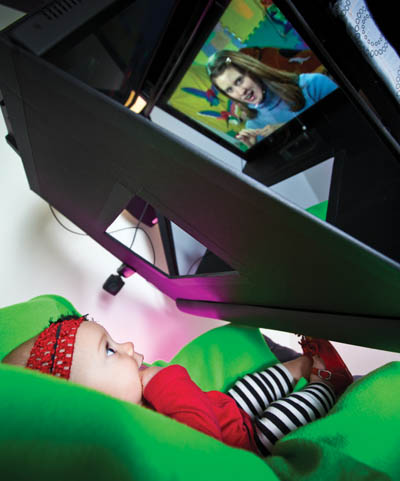 |
||
|
Using eye-tracking technology, researchers
found that infants later diagnosed with autism
showed a decline in attention to others' eyes
by two to six months of age.
|
Autism is usually diagnosed after age two, when delays in a child’s social behavior and language skills become apparent. This new study found that babies as young as two to six months old can start to show a decrease in eye contact—a clear sign of autism.
This research, published online in Nature, also suggests that there’s a window of opportunity to possibly prevent some disabilities associated with the disorder.
Lack of eye contact has been a hallmark diagnostic sign of autism since the condition was initially identified. But no one knew how early this deficit began. To find out, researchers at the Marcus Autism Center in Atlanta used eye-tracking equipment to measure eye movements in babies who watched video scenes of a caregiver.
Followed from birth to three years, the infants were divided into two groups based on their risk for developing an autism spectrum disorder. Those in the high-risk group had an older sibling already diagnosed with autism; the low-risk group did not. The researchers calculated the percentage of time each child fixated on the caregiver’s eyes, mouth and body, as well as the non-human spaces in the images.
By age three, nearly all the children in the high-risk group had received a clinical diagnosis of an autism spectrum disorder. The researchers then reviewed the eye-tracking data to determine which factors differed between children who received an autism diagnosis and those who did not.
“In infants later diagnosed with autism, we see a steady decline in how much they look at mom’s eyes,” says Warren Jones, PhD, lead author of the study.
This drop in eye fixation began between two and six months and continued throughout the course of the study. By 24 months, the children who were later diagnosed with autism focused on the caregiver’s eyes only about half as long as did their typically developing counterparts. Also, those infants whose levels of eye contact diminished most rapidly were those who were most disabled later in life.
Importantly, these results suggest that social engagement skills are intact after birth in children with autism. This finding challenges a long-standing theory—that social behaviors are entirely absent in children with autism. In other words, the observation of a decline in eye fixation—rather than an outright absence—offers a promising opportunity for early intervention.
“This insight—the preservation of some early eye-looking—is important,” Dr. Jones says. “In the future, if we were able to use similar technologies to identify early signs of social disability, we could then consider interventions to build on that early eye-looking and help reduce some of the associated disabilities that often accompany autism.”
In the meantime, the investigators’ next step is to translate this research into a viable tool for use in the clinic.
“Most kids on the autism spectrum are not identified until later, so looking early is helpful,” says Glen T. Steele, OD, professor of pediatric optometry at Southern College of Optometry and chair of the AOA’s InfantSEE Committee.
Optometrists who examine babies and very young children aren’t expected to make the diagnosis of autism, Dr. Steele says. “But we might be able to notice these issues much earlier in life, and a caution flag should go up.” If you suspect autism, refer the child to a developmental specialist who regularly works with children with special needs, he says.
Jones W, Klin A. Attention to eyes is present but in decline in 2-6-month-old infants later diagnosed with autism. Nature. 2013 Nov 6. [Epub ahead of print.]

